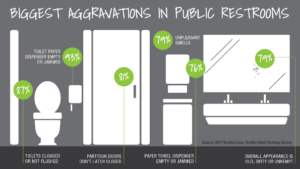An unpleasant restroom experience can turn customers away, perhaps even garnering a bad review. However, clean, well-maintained restrooms can be customer magnets.
A new survey shows how businesses ultimately pay a price for having unpleasant restroom conditions—and reap the rewards of providing good ones.
More than half (56 percent) of American adults said they are unlikely to return to a business after experiencing unpleasant restrooms, according to the Healthy Hand Washing Survey by Bradley Corp., manufacturer of commercial washroom products. Other disheartened customers will complain to management, tell a friend, post a comment on social media or leave right away without completing their business.
Conversely, businesses that have pleasant, well-maintained restrooms can turn into customer magnets. Almost three-quarters (70 percent) of Americans say they have made a conscious effort to select a specific business because it has restrooms that are cleaner and better maintained. That number is even higher for millennials—77 percent of respondents aged 18 to 34 say they’ve patronized certain businesses because they have cleaner restrooms.
(70 percent) of Americans say they have made a conscious effort to select a specific business because it has restrooms that are cleaner and better maintained. That number is even higher for millennials—77 percent of respondents aged 18 to 34 say they’ve patronized certain businesses because they have cleaner restrooms.
“Depending on their condition, public restrooms can become significant business liabilities—or ringing endorsements,” Jon Dommisse, director of global marketing and strategic development for Bradley Corp., said.
Dommisse noted that good restrooms “invite positive customer reinforcement” and “clearly give businesses a competitive edge,” likely resulting in more sales.
Moreover, expectations for a business’ restrooms are clearly tied to customers’ perceptions of the quality of the goods or services. According to the survey, 92 percent of respondents expect that a business that provides high-quality products or services would also have restrooms that deliver a high-quality experience.
Despite the high value that customers put on restroom conditions, the survey uncovered an adverse trend showing that more businesses are at an increased risk for losing customers because of messy facilities. In 2017, almost 70 percent of Americans said they recall having an unpleasant restroom experience—that number was only 60 percent in 2015.
Dommisse said keeping regular scheduled maintenance on the radar is essential, citing the following common restroom aggravations uncovered by the survey: empty or jammed toilet-paper dispensers (mentioned by 93 percent of respondents); clogged or unflushed toilets (87 percent); stall doors that do not latch (81 percent); bad smells (79 percent); and an overall appearance that is old, dirty, or unkempt (79 percent).
Further, Americans do not like touching things in public restrooms, and they use all sorts of techniques to avoid coming into contact with surfaces, such as relying on their foot to operate the toilet flusher, using a paper towel to grasp the door handle, and hovering over the toilet seat.
When asked what restroom improvements they would like to see, it is not surprising cleanliness topped the list. After that, Americans want touchless fixtures and better stocking of supplies, such as toilet paper, soap, and paper towels.
